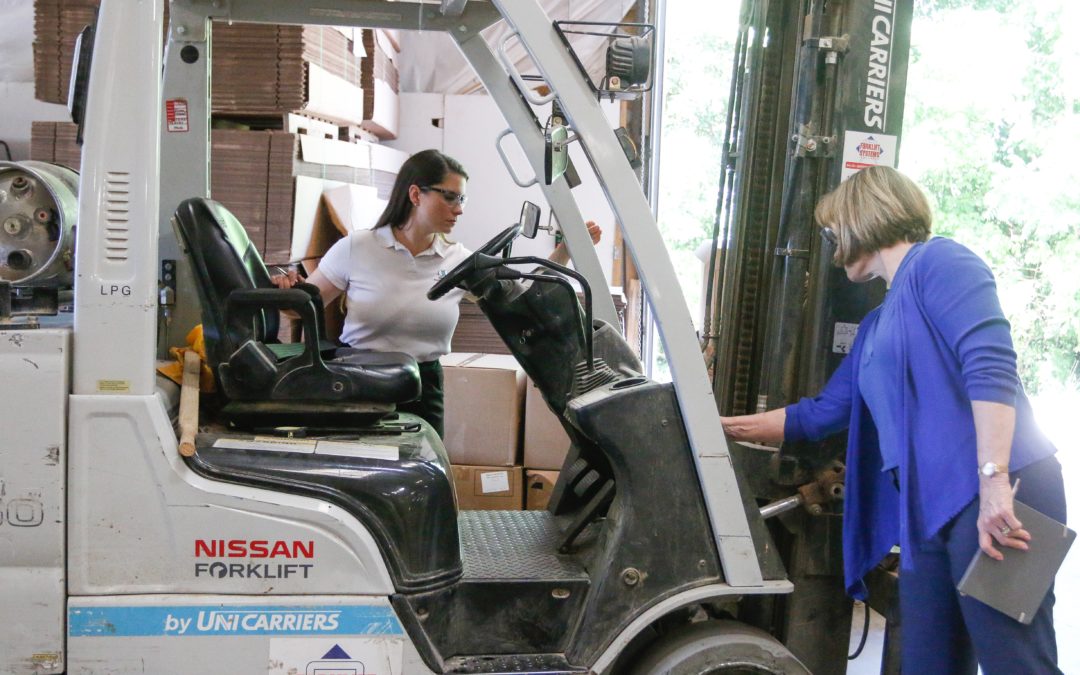Powered industrial trucks (PITs) are commonly used in industry to carry, push, pull, lift, stack, or tier materials. The hazards associated with PITs vary depending on the vehicle type, workplace environment, and application. Without proper training and understanding of regulations governing the use of PITs in general industry, OSHA 1910.178 and ANSI B56.1-1969, this type of equipment can present a serious risk to workplace safety. Below are a few statistics regarding the use and hazards of PITs:
- There are approximately 1.2 million forklift operators in the United States.
- 8% of all fork trucks will be involved in an accident annually.
- 68,400 fork truck accidents occur each year.
- Approximately 85 fatalities occur annually.
- 34,900 serious injuries occur annually.
In this blog, we will discuss the types and designations, modifications, and training requirements of PITs.
Types of Powered Industrial Trucks and Designations
OSHA defines a PIT as a specialized motor vehicle used in the workplace. Types of PITs include but are not limited to:
- Forklifts,
- Scissor lifts,
- Sweepers,
- Order pickers,
- Powered Pallet jacks, and
- Golf Carts.
There are various designations of PITs relating to the type of engine, fuel source, and safety guards on the equipment. Understanding the workplace hazards and the capabilities of the PITs are critical for maintaining a safe work environment.
| Designation | Description |
| D | The D designated units are diesel engine powered rather than gasoline engine powered. They have the minimal acceptable safeguards against inherent fire hazards. |
| DY | The DY designated units are diesel powered units that have all the safeguards of the DS units and in addition do not have any electrical equipment including the ignition and are equipped with temperature limitation features. |
| DS | The DS designated units are diesel powered units that are provided with additional safeguards to exhaust, fuel and electrical systems. They may be used in some locations where a D unit may not be considered suitable. |
| E | The E designated units are electrically powered units that have minimum acceptable safeguards against inherent fire and electrical shock hazards. |
| ES | The ES designated units are electrically powered units that, in addition to the entire requirement of the E units, are provided with additional safeguards to the electrical system to prevent emission of hazardous sparks and to limit surface temperatures. They may be used in some locations where the use of an E unit may not be considered suitable. |
| EE | The EE designated units are electrically powered units that have, in addition to all of the requirements for the E and ES units, the electric motors and all other electrical equipment completely enclosed. In certain locations the EE unit may be used where the use of an E and ES unit may not be considered suitable. |
| EX | The EX designated units are electrically powered units that differ from the E, ES, or EE units in that the electrical fittings and equipment are so designed, constructed and assembled so that the units may be used in certain atmospheres containing flammable vapors, dusts, and under certain conditions, fibers. Type EX units are specifically tested and classified for use in Class 1, Group D or Class 2, Group G hazardous locations as defined in the National Electric Code, NFPA 70. |
| G | The G designated units are gasoline powered units having minimum acceptable safeguards against inherent fire hazards. |
| GS | The GS designated units are gasoline-powered units that are provided with additional safeguards to the exhaust, fuel and electrical systems. They may be used in some locations where the use of a G unit may not be considered suitable. |
| LP | The LP designated unit is similar to the G unit except that liquefied petroleum gas is used for fuel instead of gasoline. These units have minimum acceptable safeguards against inherent fire hazards. |
| LPS | The LPS designated units are liquefied petroleum gas powered units that are provided with additional safeguards to the exhaust, fuel and electrical systems. They may be used in some locations where the use of an LP unit may not be considered suitable. |
Modifications
An attachment is a device, other than conventional forks or load backrest extension, mounted permanently or removable on the elevating mechanism of a truck for handling the load. Popular attachments are fork extensions, drum holders, clamps, rotating devices, side shifters, load stabilizers, rams, and booms.
Modifications and additions that affect capacity and safe operation are not allowed to be performed by the customer or user without the manufacturer’s prior written approval or without the design and approval of a Professional Engineer. Capacity, operation, maintenance instruction plates, tags, or decals must be changed accordingly.
Training Requirements
All PIT operators must receive training for the specific type of equipment that will be used. Training, performed by a Competent Instructor, consists of both formal training (i.e. lecture), practical exercises, and evaluation of the operator’s skills in the workplace. Once an employee has successfully completed training an Operator License will be awarded and be rated for the equipment that was the focus of the training. An evaluation of each PIT operator’s performance must be conducted at least once every three years.
Our team of experts have over 40 years of experience with training, developing, and implementing PIT safety programs. Contact us today to set up a consultation and get your facility in compliance! Due to the COVID-19 impact, We now offer an additional training option to perform remote live training program options.

